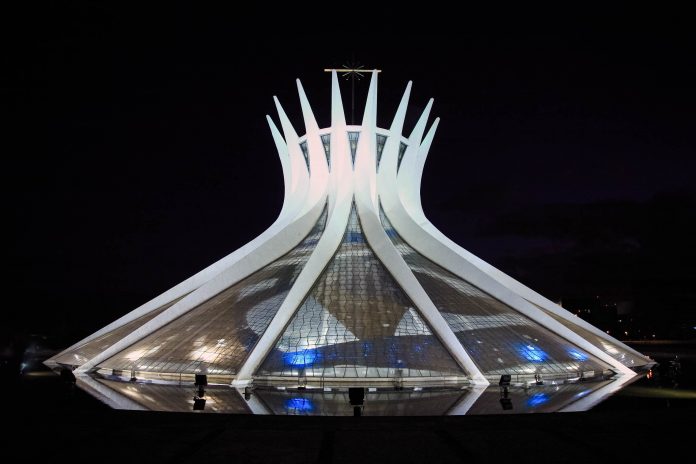Brasilia ist die größte Planstadt der Welt. Ihr imposantes Erscheinungsbild voller einzigartiger Bauwerke ließ bei ihrer Eröffnung die ganze Welt staunen – hier sind unsere Top 10 Sehenswürdigkeiten!
Einst war es Rio de Janeiro – nun ist Brasilia die Hauptstadt von Brasilien. Brasilia ist die größte Stadt der Welt, die durch und durch auf dem Reißbrett geplant wurde. Der damalige Präsident Juscelino Kubitschek ließ seine Vision einer perfekten Stadt genau in der Mitte von Brasilien in Beton gießen.
In nur 5 Jahren wurde Brasilia aus dem staubigen Boden der brasilianischen Savanne gestampft und am 21. April 1964 eingeweiht – zuvor war hier NICHTS. Städteplaner Lucio Costa, Architekt Oscar Niemeyer und Landschaftskünstler Burle Marx konnten sich hier verwirklichen. Sie schmückten die Planstadt mit ihren einzigartigen Werken, die Brasilia 1987 einen Platz auf der Liste des UNESCO-Weltkulturerbes bescherten.
Aus diesem Grund sind auch unsere Top 10 Sehenswürdigkeiten von Brasilia zum Großteil aus Stein, Stahl und Glas.
Das Zentrum der Hauptstadt ist das eindrucksvolle Regierungsviertel. Unter der Woche wuseln hier die 200.000 Beamten durch die Gegend, die im Regierungsviertel arbeiten und etwa 10% der Bevölkerung Brasilias ausmachen. Am Wochenende ist das arbeitende Volk zu Hause und das Regierungsviertel Brasilias wie ausgestorben.
Inhaltsverzeichnis
Teatro Nacional Cláudio Santoro
Das moderne Nationaltheater von Brasilia ist der ideale Ausgangspunkt für einen Rundgang durch das Regierungsviertel. Es wurde nach Plänen von Oscar Niemeyer im Jahr 1966 vollendet. Benannt ist es nach dem bekannten brasilianischen Komponisten Cláudio Santoro aus Manaus, der 1989 in Brasilia verstarb.
Platz der Drei Gewalten (Praça dos Três Poderes)
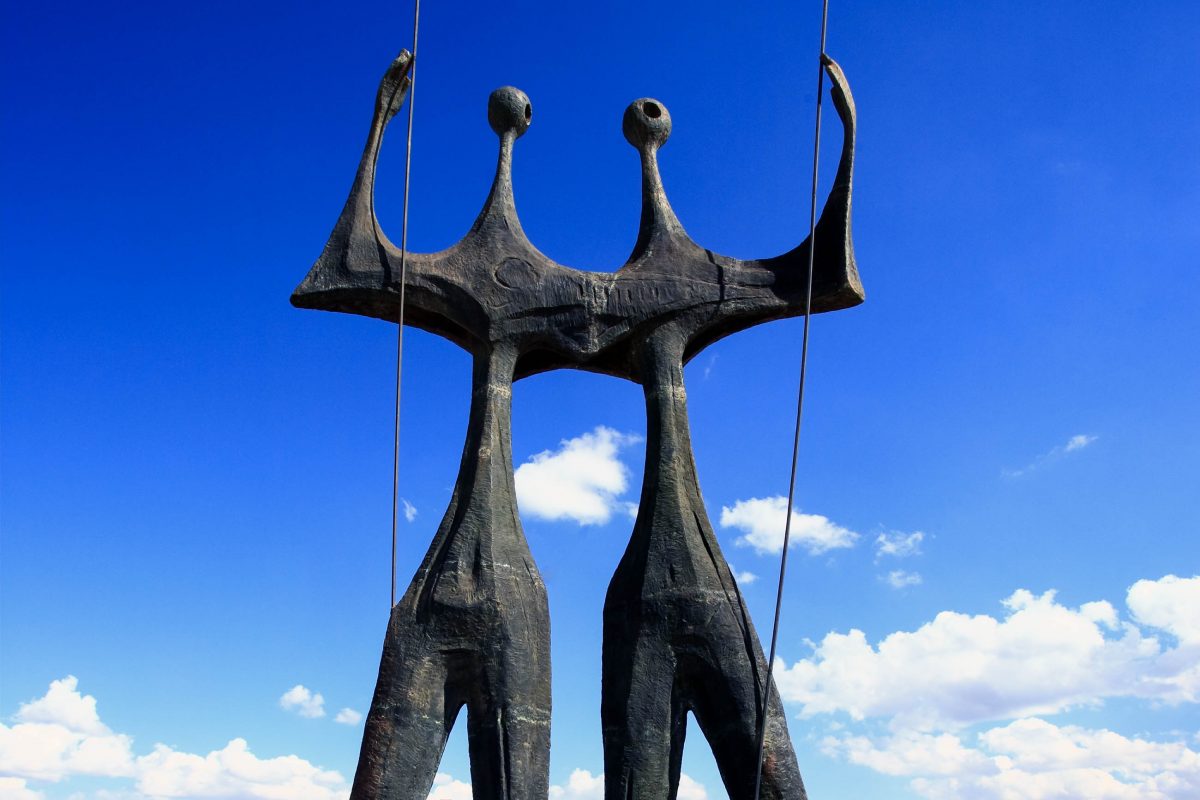
Der weitläufige Praça dos Três Poderes bildet das Zentrum von Brasilia. Hier treffen sich die drei Gewalten Exekutive, Legislative und Judikative. Die Skulptur „Die Krieger“ („The Candangos“) von Bruno Giorgi thront ebenfalls am Platz der drei Gewalten.
1986 wurde an der Westseite des Platzes, der bisher unbebaut war, das Pantheon des Vaterlandes und der Freiheit Tancredo Neves (Panteão da Pátria e da Liberdade Tancredo Neves) eröffnet. Das Gebäude ist den „Nationalhelden“ Brasiliens gewidmet, unabhängig ob es sich dabei um In- oder Ausländer handelt. Die Namen der Nationalhelden werden in einem Buch im 3. Stock festgehalten.
Präsidentenpalast
An der Nordseite des Platzes thront der futuristisch anmutende Palácio do Planalto. Hier ist der offizielle Arbeitssitz des brasilianischen Präsidenten. Der Haupteingang wird nur bei Staatsbesuchen genutzt und von der Präsidentengarde bewacht. Der Zugang erfolgt sonst über den Nordeingang. An Sonntagen gibt es 20-minütige geführte Touren durch den Präsidentenpalast.
Nationalkongress
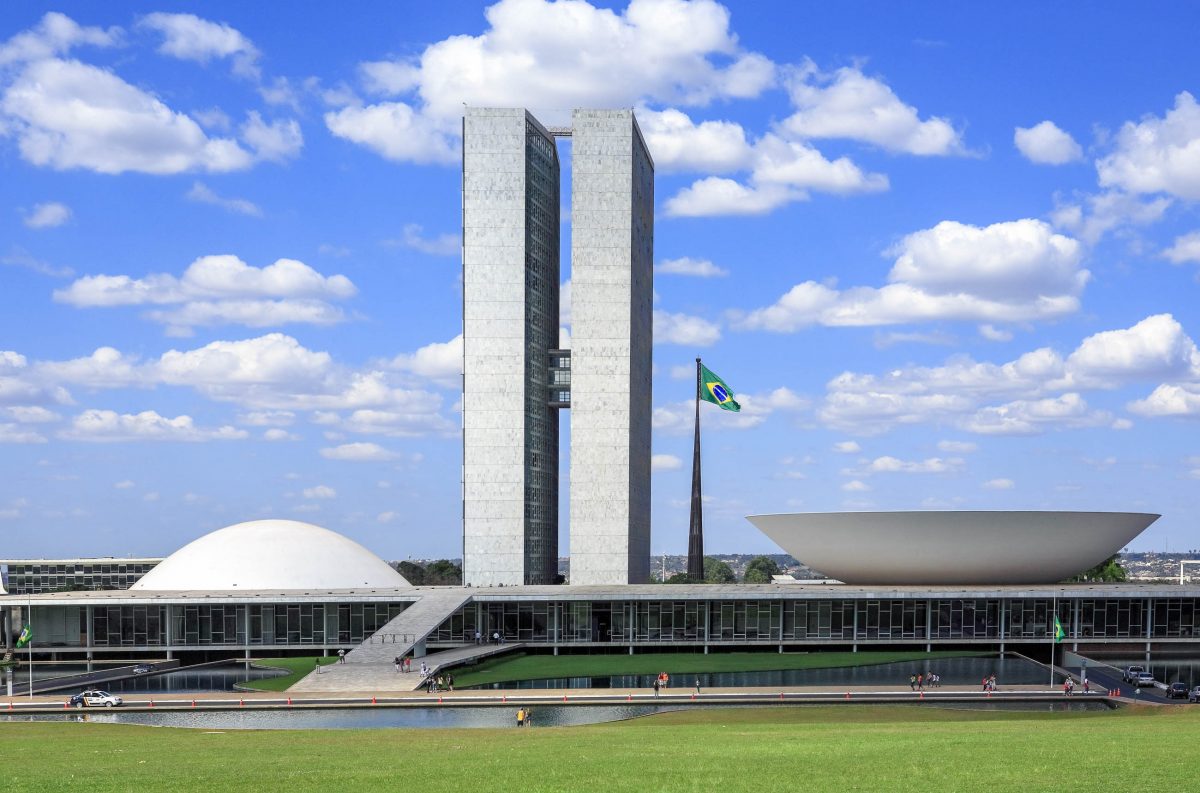
Dominiert wird der Platz der Drei Gewalten jedoch nicht vom Palácio do Planalto, sondern von den mächtigen Zwillingstürmen des Nationalkongresses. Die beiden gigantischen Zylinder aus Stahl und Beton beherbergen die Büroräumlichkeiten der Abgeordneten und sind durch Tunnel unterirdisch mit anderen zugehörigen Bauten des Nationalkongresses verbunden.
Oberster Gerichtshof
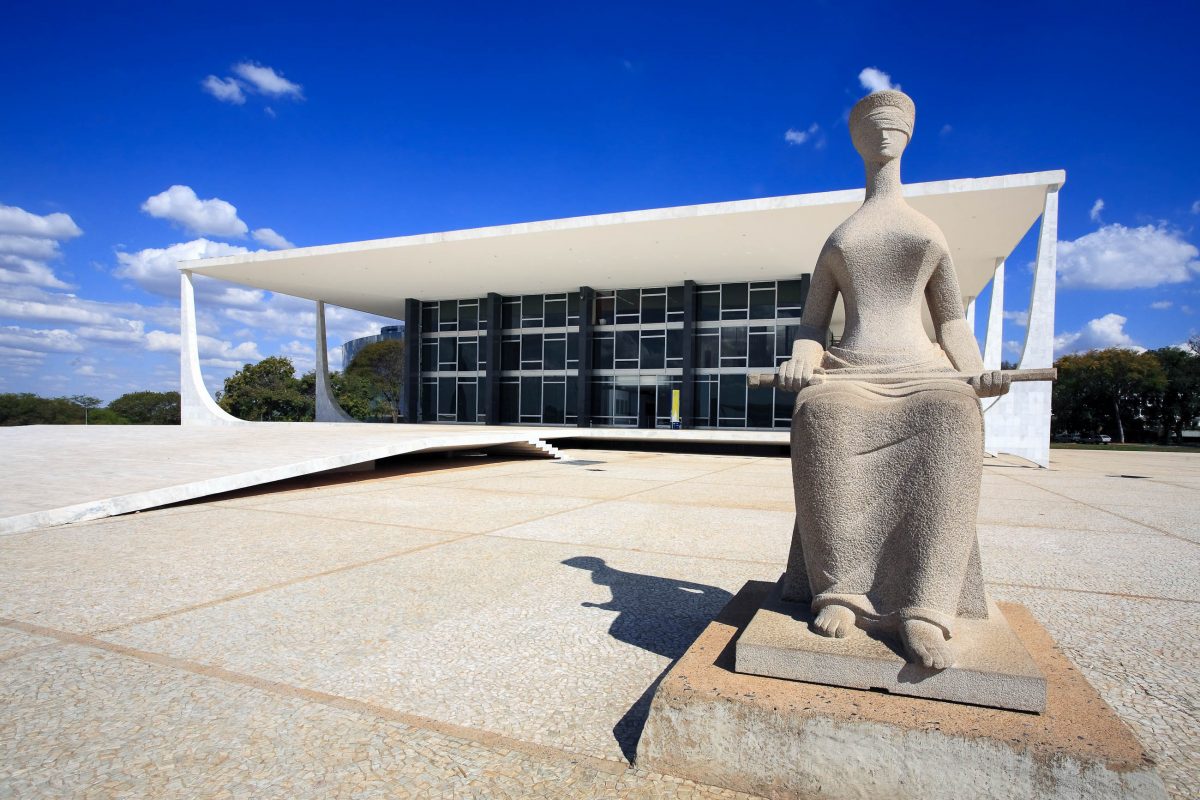
Das flache Gebäude des obersten Gerichtshofs (Supremo Tribunal Federal) komplettiert die drei Gewalten. Es befindet sich an der Südseite des Platzes und wird durch ein riesiges schneeweißes Flachdach beherrscht. Davor sitzt majestätisch die symbolische Statue der Judikative mit verbundenen Augen.
Catedral Metropolitana
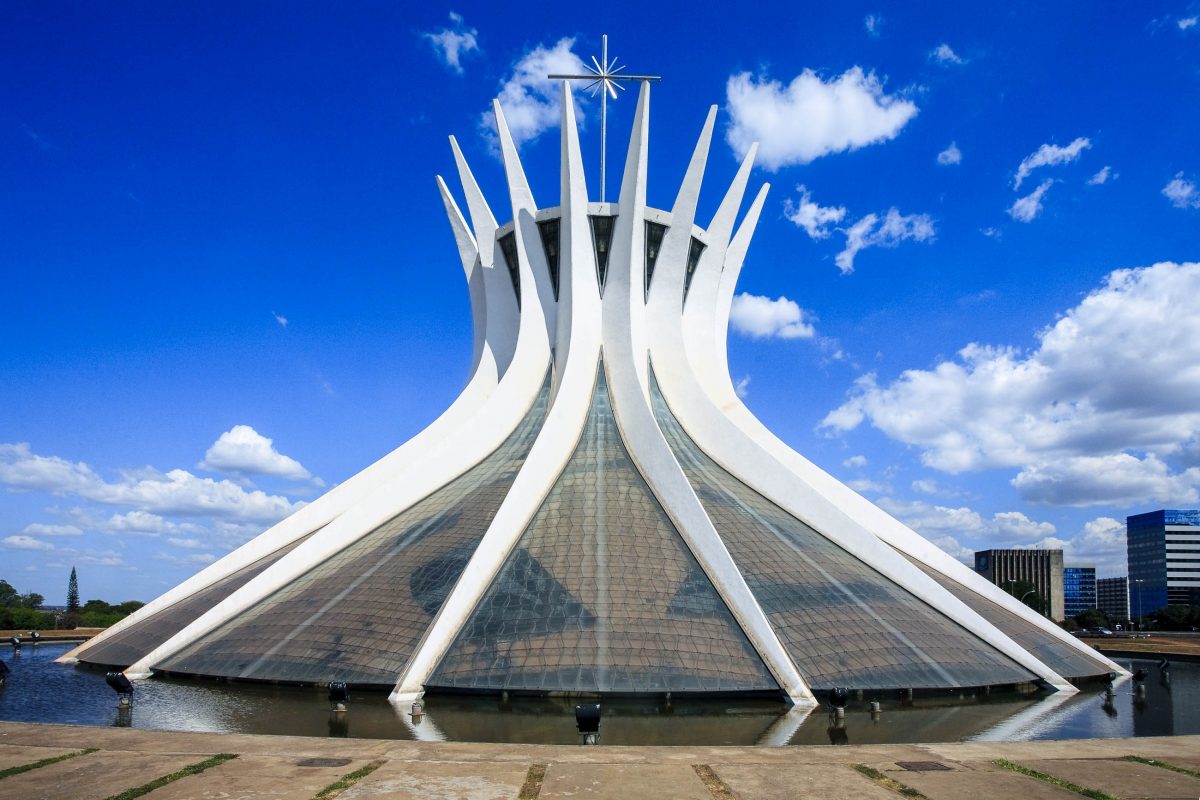
Die Kathedrale von Brasilia (Catedral Metropolitana) zählt wohl zu den eindrucksvollsten Bauten im Regierungsviertel. Auf den ersten Blick würde man niemals denken, dass dieses moderne Ungetüm aus Glas, Beton und spitzen Stacheln eine Kathedrale sein soll.
Auf seinem kreisrunden, 70m messenden Grundriss, an dem sich 16 schlanke schneeweiße Streben nach oben schwingen, bietet das ungewöhnliche Gotteshaus von Brasilia 4.000 Gläubigen Platz. Durch das viele Glas, das noch dazu bunt bemalt ist, ist die Kathedrale bei Sonnenschein hell durchflutet. Die einzigartige Deckenkonstruktion, von der drei Engelstatuen schweben, schafft einen ganz besonderen Flair.
Artikel: Catedral Metropolitana in Brasila
Fotogalerie: Catedral Metropolitana in Brasilia
Santuário Dom Bosco
Auch das Santuário Dom Bosco, direkt am 15. Breitengrad erbaut, kann als ungewöhnliche Kirche bezeichnet werden. Sie wurde dem Schutzpatron der Stadt geweiht und öffnete 1963 ihre Pforten. Ihr Äußeres ist um einiges schlichter als das der Kathedrale, ihr Interieur beeindruckt jedoch ebenso, denn der gesamte Innenraum wird von Fenstern aus blauem Muranoglas begrenzt.
Die unterschiedlichen Farbtöne erinnern an einen sternenklaren Nachthimmel, der der Wallfahrtskirche eine interessante, angenehm kühle Atmosphäre verleiht. Auch der gigantische Kronleuchter besteht aus Muranoglas. Das riesige Kreuz über dem Altar wurde von Gotfredo Tralli aus einer einzigen Zeder geschnitzt.
Nationalmuseum in Brasilia („Museu Nacional da República“)
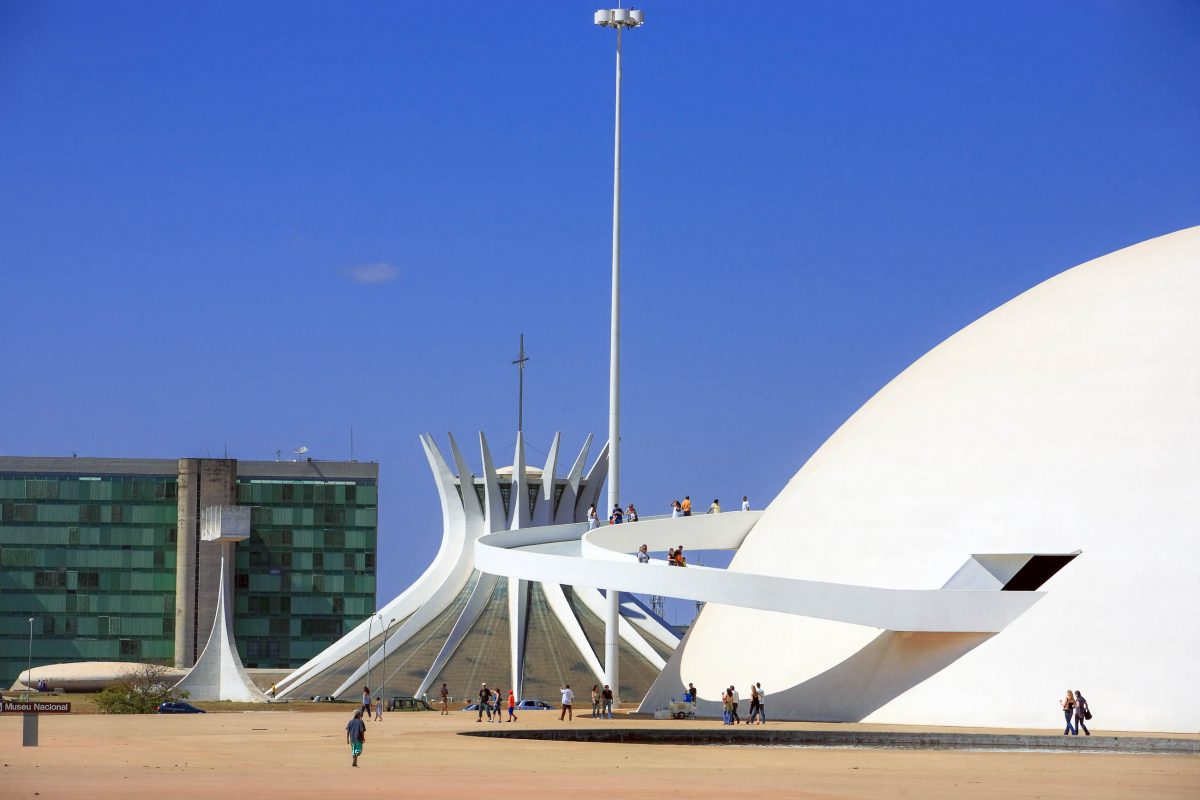
Das brasilianische Nationalmuseum in Brasilia wird auch „Museu Nacional Honestino Guimarães“ genannt, nach dem Studentenführer Honestino Guimarães. Das Nationalmuseum wurde im Jahr 2006 mit der Ausstellung „Niemeyer und Brasilia – Erbe der Menschheit“ feierlich eingeweiht. Zwei gewaltige Rampen führen zum Eingang des kuppelförmigen Museums.
Neben den Ausstellungsräumlichkeiten, in denen immer wieder neue Exhibitionen präsentiert werden, beherbergt das Museum auf seiner Fläche von 14.500 Quadratmetern ein Labor und ein Auditorium, das 780 Besuchern Platz bietet. Letzteres wird häufig für Aufführungen von Opern, Symphonien oder Kammermusik genutzt.
Gemeinsam mit der Nationalbibliothek bildet das Nationalmuseum das kulturelle Herzstück Brasilias. Dieser Complexo Cultural da República liegt direkt an der Eixo Monumental, der Hauptverkehrsachse Brasilias. Beide Gebäude wurden von Oscar Niemeyer entworfen und am 15. Dezember 2006, zu Niemeyers 99. Geburtstag, eröffnet.
Nationalbibliothek von Brasilia („Biblioteca Nacional de Brasília“)
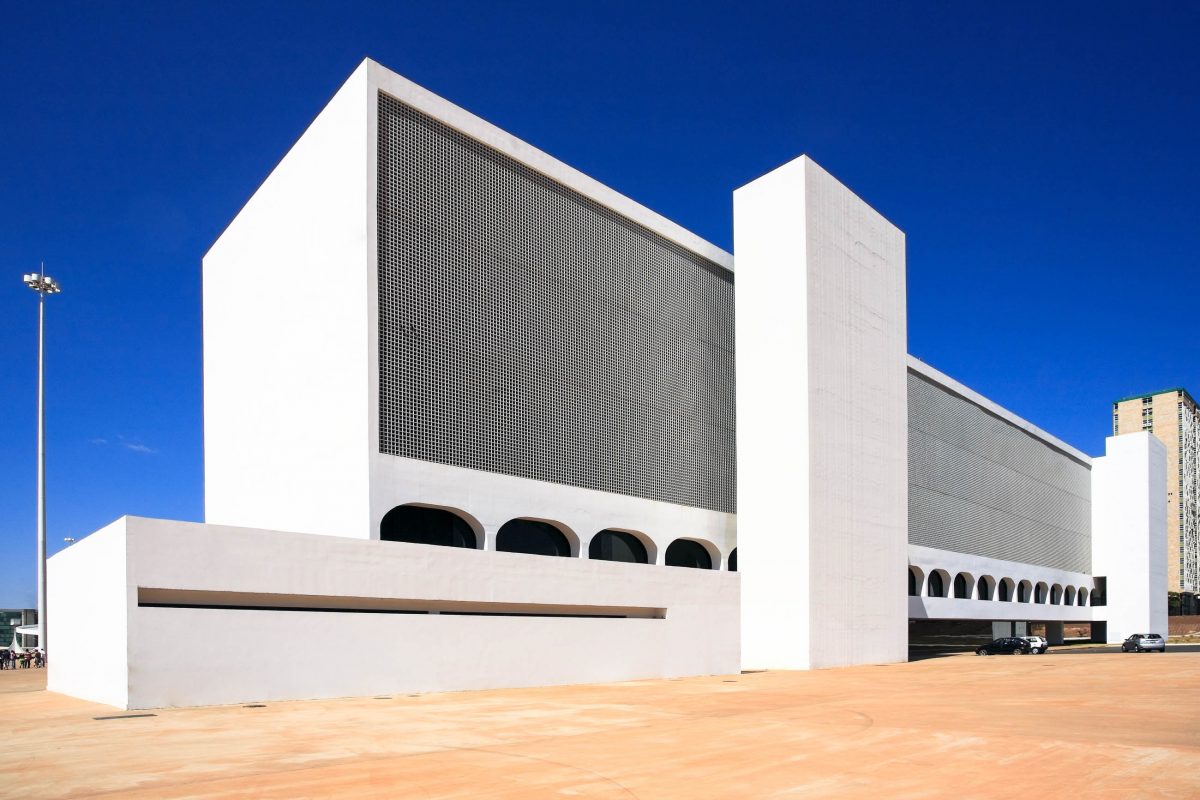
Die brasilianische Nationalbibliothek in Brasilia ist eines der mächtigsten Bauwerke im Regierungsviertel von Brasilia. Das eindrucksvolle Gebäude wird nicht als Hüterin der geistigen Schätze Brasiliens gesehen, sondern als Bibliothek mit Bildungsauftrag. Sie soll im Allgemein als Service und Dienstleistung für die Bevölkerung fungieren.
Mit diesem Hintergrund wurde sie auch im Dezember 2008 für die Öffentlichkeit zugänglich gemacht. Somit dient die Nationalbibliothek von Brasilien nicht nur der Erhaltung des kulturellen Erbes oder der Recherche von Wissenschaftlern, sondern steht auch jeder Privatperson Brasiliens offen.
Die brasilianische Nationalbibliothek beherbergt auf einer Fläche von 14.000 Quadratmetern eine gewaltige literarische Sammlung von über 300.000 Werken. Bis 2012 entstand diese Sammlung ausschließlich durch Spenden, erst 2013 wurde erstmals ein Budget für den Kauf von Büchern und elektronischen Dokumenten zur Verfügung gestellt. Den Werken zu brasilianischen Themen ist eine eigene Abteilung gewidmet. Eine Reihe von Lese- und Studierräume sowie Hörsäle laden zum Schmökern und Zuhören ein.
Torre de TV (Fernsehturm)
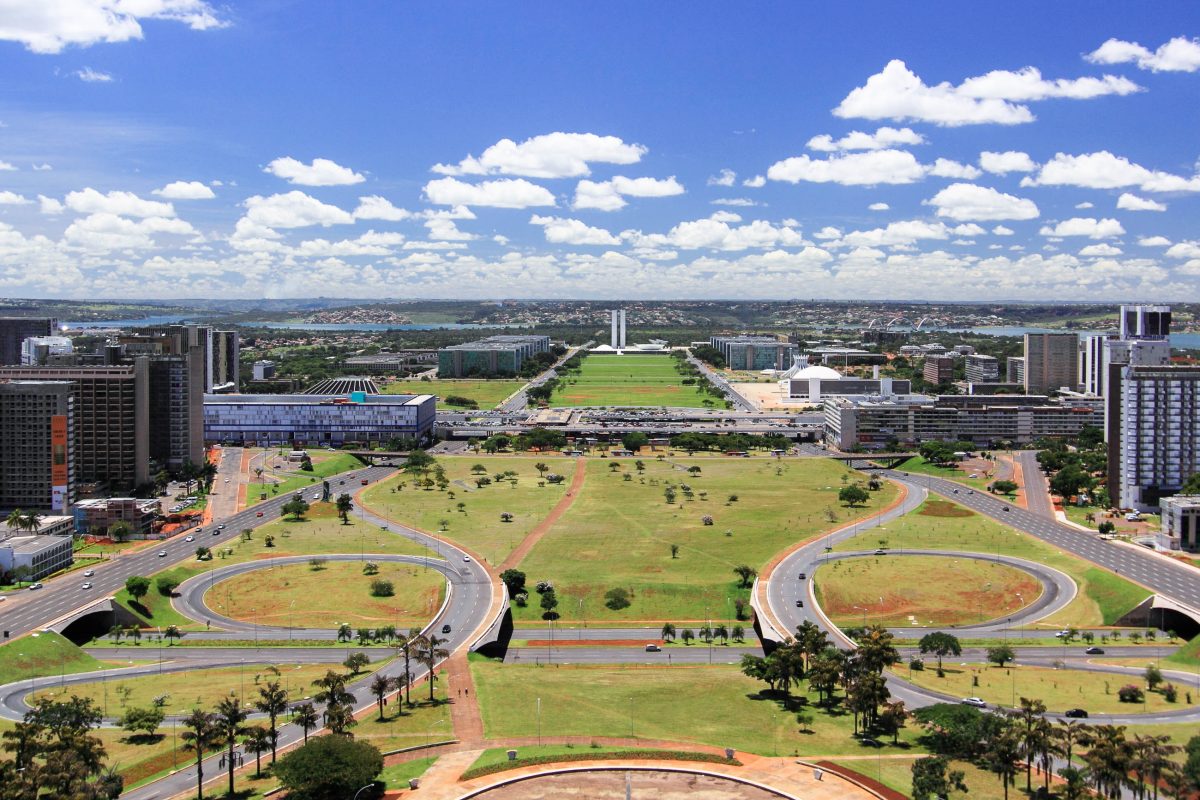
Vom 224 Meter hohen Fernsehturm von Brasilia bietet sich ein perfekter Überblick über das komplett symmetrisch angelegte Regierungsviertel. Die Aussichtsplattform liegt in 74 Metern Höhe und ist kostenlos zugänglich.
Am Fuß des Fernsehturms lockt der Markt Feira do Torre Einheimische und Touristen mit Kunsthandwerk und Street Food aus ganz Brasilien. Sonntags sind noch mehr Stände als sonst geöffnet und es herrscht ausgelassene Stimmung, die an einen Jahrmarkt erinnert.
Tipp: Den besten Überblick über die fantastischen Bauten und die gewaltigen Ausmaße des Regierungsviertels erhält man im Zuge eines Helikopter-Fluges, der in der Nähe des Fernsehturms gebucht werden kann.
Lago Paranoá und Palácio do Alvorado
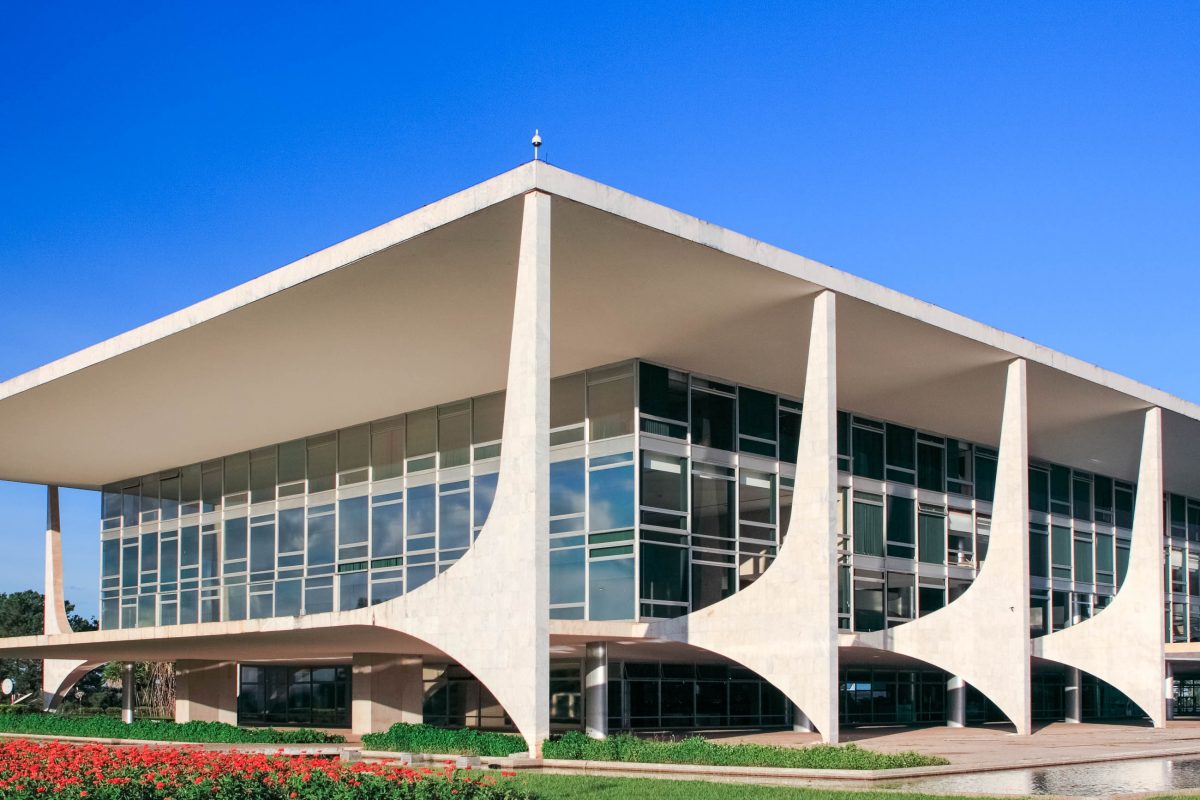
Der „Palast des Sonnenaufgangs“ ist der Sitz des amtierenden Präsidenten von Brasilia. Auch er wurde natürlich von Oscar Niemeyer errichtet. Er kann leider nicht von innen besichtigt werden, doch auch seine Umgebung ist einen Besuch wert.
Der Palacio do Alvorado liegt nämlich auf einer Halbinsel direkt am Ufer des künstlichen Lago Paranoá. Mit seinen drei Inseln ist er das Sport- und Freizeitzentrum von Brasilia. Der maximal 38 Meter tiefe See zählt zu den saubersten Seen der Welt und lädt mit künstlichen Stränden zum Baden ein. Segeln, Kanufahren, Rudern, Wakeboarden und Angeln gehören zu den beliebtesten Wassersportarten am Lago Paranoá.
Taucher sind hier ebenfalls des Öfteren anzutreffen. Die meisten von ihnen sind auf der Suche nach dem Schiffswrack oder dem Dorf Amaury, die beide am Grund des Sees liegen.
Über den See spannen sich die 61 Meter hohe Bögen der Juscelino-Kubitschek-Brücke, ein weiteres Wahrzeichen der brasilianischen Hauptstadt. Die nach dem Gründer Brasilias benannte Brücke wurde von Alexandre Chan als Verlängerung der Ost-West-Achse Eixo Monumental errichtet.
Artikel: Lago Paranoá in Brasilia
Parque da Cidade
Wer in Brasilia etwas Grün sucht, ist im Stadtpark richtig. Der gigantische Freizeitpark kann zur Gänze mit dem Auto durchfahren werden. Am Wochenende trifft sich hier die halbe Bevölkerung Brasilias, trotzdem wirkt das riesige Areal nie überlaufen.
Zu seinen Sehenswürdigkeiten zählt unter anderem das riesige Juscelino-Kubitschek-Denkmal, auch JK-Memorial genannt. Die fast 5 Meter hohe Statue gilt als eines der besten Werke von Oscar Niemeyer. Sie zeigt das Konterfei des Präsidenten und seine Medaillen und Ehrungen, mit denen er zu Lebzeiten ausgezeichnet wurde. Bis heute wird Juscelino Kubitschek in Brasilien verehrt wie kein anderer Präsident. Auch seine Grabstätte ist hier zu finden.
Tipp: Ebenfalls Natur pur gibt es im Nationalpark von Brasilia. Dieser liegt etwas außerhalb des Zentrums. Er beherbergt mineralische Quellen und eine große Artenvielfalt an Pflanzen und Tieren, darunter Nandus, Wasserschweine, Gürteltiere, Pampashirsche, Kaimane, Jaguare und Anakondas. Ebenfalls sehenswert ist der Parque Municipal do Itiquira mit dem höchsten Wasserfall Brasiliens.
Estadio Nacional
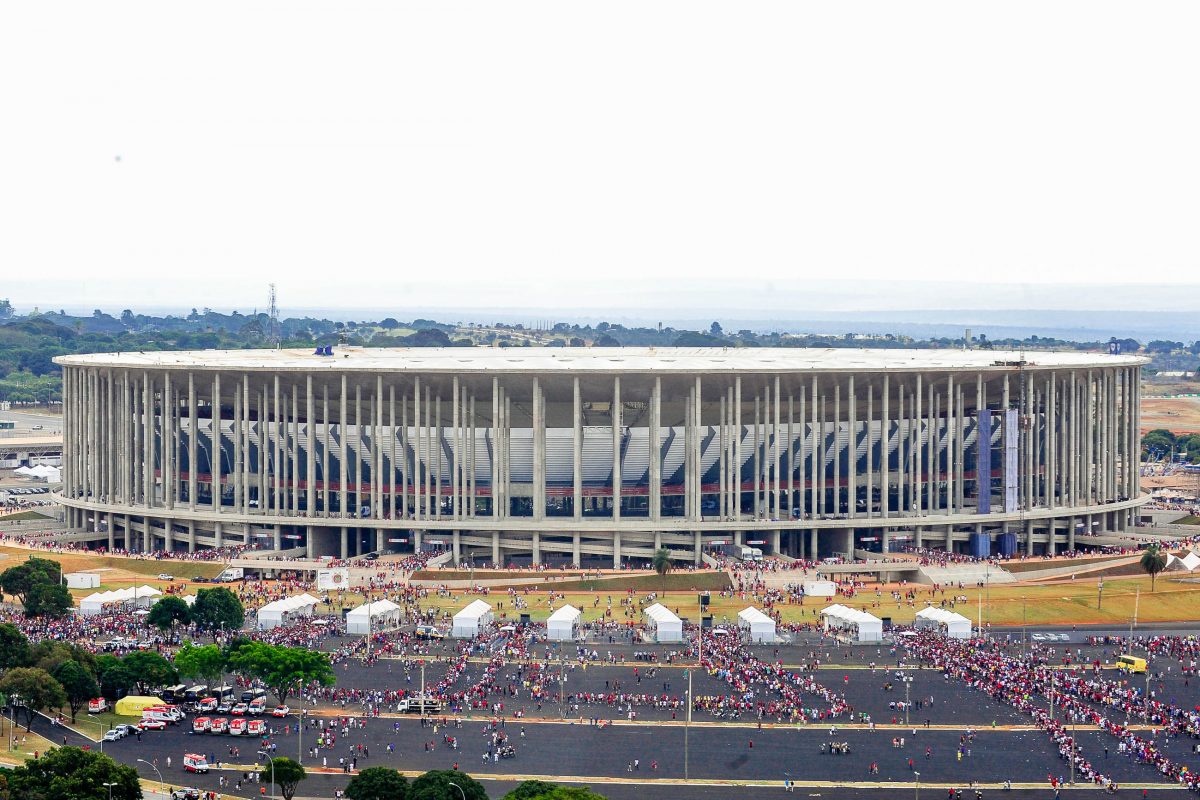
Brasilias Fußballstadion ist nach dem Maracanã-Stadion in Rio de Janeiro das zweitgrößte Stadion des Landes und eines unserer 13 wichtigsten Fußballstadien Brasiliens. Es wurde am 18. Mai 2013 für die Fußball-WM 2014 eröffnet. Mit (Um)Baukosten von 450 Millionen Euro war es die teuerste Spielstätte der Fußball-WM 2014.
Artikel: Die 13 wichtigsten Fußballstadien Brasiliens
Entstehung der Hauptstadt Brasilia
Den Traum einer neu zu schaffenden Hauptstadt für das riesige Brasilien gibt es schon seit 1891. Damals philosophierte der italienische Priester (und heutiger Stadtpatron) São João Bosco von einer utopischen Stadt in der Neuen Welt. Der Beschluss dafür wurde sogar in der Verfassung verankert.
Bis es dann soweit war, verging jedoch noch einige Zeit. Erst der Präsident Juscelino Kubitschek, der seine Amtszeit 1956 begann, setzte das Projekt unter dem Slogan „50 Jahre Fortschritt in fünf Jahren“ um.
Brasilia steht in starkem Kontrast zu den berühmten Kolonialstädten des Landes, die über Jahrhunderte entstanden sind. Brasilia ist im Gegensatz dazu eine avantgardistische, in Beton gegossene, von vorne bis hinten durchgeplante Stadt und die einzige Hauptstadt der Welt, die komplett am Reißbrett entwickelt wurde.
Betrachtet man den Grundriss von Brasilia aus der Vogelperspektive erkennt man die Form eines Flugzeuges. Der Platz der Drei Gewalten steht für das Cockpit, am Rumpf versammeln sich Regierungs-, Kulturgebäude, Hotels und Banken und die Tragflächen beherbergen die Wohngebiete von Brasilias Bevölkerung.

